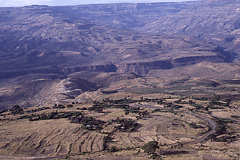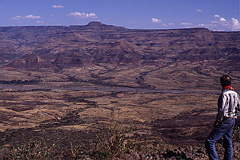

|

1. Ambo Springs - Farisi locality - The site is near Ambo. It is topographically high at 7,000 ft. elevation, but its stratigraphic position remains unclear. Outcrops expose variegated red and gray mudstones with interbedded yellow limestone lenses. A ledge forming silty limestone yields ganoid fish scales, turtle shell fragments, archosauromorph (possibly theropod or thecodont) vertebrae and teeth, crocodilian teeth and scutes.
2. Butoro - The site, at an elevation of 6,200 feet, is not far from the Mugher Limestone Quarry and appears to be in the Mugher Mudstone, but likely stratigraphically higher than the Aleltu locality. Abundant fish, turtle, and crocodilian remains were found in these local badlands of predominantly sandy, red mudstone.


|
Fig. 6 - Overlooking the Blue Nile Gorge.
At left, the rim of the Blue Nile Gorge is a mile above the Abay or Blue Nile River. As much as possible, the slopes off the rim are cultivated and small villages dot the landscape. At right, a view across the Wenchit River Valley.
3. Aleltu Quarry, Mugher Valley, Bole tributary of Aleltu River - A concentration of fragmentary bones and plant material was found in a green mudstone overlying a fossil plant horizon. Vertebrates are represented by abundant ganoid scales, fish spines, lungfish tooth plates, an association of crocodilian scutes, vertebrae, and limb elements, and fragments of turtle shell. This locality is low in the section and relatively close to the Anatolo Limestone in the vicinity of the type section of the Mugher Mudstone.
4. Jema River, South Bank - Some poorly preserved bone fragments and teeth found in a heavily-weathered soil zone include shark teeth, lungfish tooth plates, ganoid scales, and crocodilian teeth and scutes.
5. Jema River, North Bank - The site was discovered in 1993 at the base of steep exposures of Mugher Mudstone along the north bank of the Jema River. Shark teeth, lungfish tooth plates and scales, fish teeth and ganoid scales, two kinds of crocodilians based on scute morphology, strongly amphicoelous caudal vertebrae suggestive of mesosuchians, and robust (> 3.5 cm in length) crocodilian teeth were discovered. Incomplete crocodylian skull bones show affinities with dyrosaurids from the Upper Cretaceous of Sudan (Buffetaut et al., 1990). Fragments of turtle shell are common and confirm the presence of at least two taxa: 1) a "thick-scaled" genus based on the preservation of strongly-ridged neurals and peripherals; and 2) a smooth, thinner-shelled genus. The discovery of a partial allosaurid tooth and a smaller, simple blade-shaped dinosaur tooth collected in 1996 provide the first confirmed record of theropod dinosaurs from Ethiopia.
6. Besola River - The site is located northwest of Alem Ketema, between the Jema and Wenchit River drainages. The fossils weather out of red and green mudstones on the north facing bank of the Besola River. Float is abundant on the surface, including numerous ganoid scales, fish and shark teeth, turtle shell fragments, crocodilian scutes and teeth, and archosauromorph vertebrae. This site is very similar in lithology and vertebrate fauna to the Jema localities.